A TAXI DISPATCH SYSTEM BASED ON CURRENT
DEMANDS AND REAL-TIME TRAFFIC
CONDITIONS
ABSTRACT: This research involves the study of the existing taxi dispatch system
employed by taxi operators inSingapore to handle current bookings. This dispatch
system adopts the Global Positioning Systems (GPS), and is based on the
nearest-coordinate method, i.e. the taxi assigned for each booking is the one with the
shortest, direct,straight-line distance to the customer location. However, the taxi
assigned under this system is often not capable of reaching the customer in the
shortest time possible. An alternative dispatch system is proposed, whereby the
dispatch of taxis is determined by real-time traffic conditions. In this proposed system,
the taxi assigned the booking job is the one with the shortest-time path, i.e. it will
reach the customer in the shortest time. This dispatch ensures that customers are
served within the shortest period of time, resulting in increased customer satisfaction.
The effectiveness of both the existing and proposed dispatch systems is investigated
through computer simulations. This study presents and analyzes the results from a
simulation model of the Singapore Central Business District (CBD) network. Data
from the simulations show that the proposed dispatch system is capable of being more
efficient in dispatching taxis more quickly; leading to more than 50% reductions in
passenger pick up time and average travel distance. A more efficient dispatch system
would result in higher standards of customer service, and a more organized taxi fleet
to better meet customer demands.
�
INTRODUCTION
Taxis play an important role in offering personalized service within Singapore’s
public transport sector (1,2). With the growing emphasis on customer satisfaction, it is
essential for taxi operators to constantly upgrade their systems and facilities to ensure
quality service.
Background
based
on
procedure
is
dispatch
(GPS). This
This research involves a study of the existing taxi dispatch system employed by
taxi operators in Singapore to handle taxi bookings, and which uses the Global
Positioning Systems
the
nearest-coordinate method, which means the taxi assigned a particular booking is the
one that is the nearest to the customer location in terms of straight-line distance.
However, the assigned taxi may not essentially be the taxi that is capable of reaching
the customer in the shortest time possible. It is therefore hypothesized that a dispatch
system based on real-time traffic conditions would be able to ensure that the taxi
assigned the booking is in fact the taxi that is capable of reaching the customer in the
fastest time. In the proposed system, the taxi assigned the booking will be the one
with the shortest travel time as derived from the traffic conditions on the roads at the
time the booking call is received. With this proposed system, customers who make
bookings may be served within the shortest time possible, bringing a closer match
between the supply and demand of taxis, and thus increasing customer satisfaction
and making taxi booking more reliable.
Objective
The main objective of this research is to verify the hypothesis that the proposed
dispatch system is more efficient than the existing dispatch system in handling taxi
bookings, in that it is able to assign the booking to the taxi that is most capable of
reaching the customer within the shortest period of time. This hypothesis is verified
through microscopic computer simulations (3). Simulation runs were performed on a
selected network chosen from the Central Business District (CBD) in Singapore.
Evaluations on the performances of both systems were then made, based on their
�
efficiency in dispatching taxis, in terms of travel
times and travel distances. A
sensitivity analysis was also carried out to investigate the influence of ‘empty-taxi’
rates on the performances of the two systems.
METHOD OF INVESTIGATION
This research began with the identification and analysis of the shortcomings of
the existing dispatch system, followed by the collection of all relevant information for
simulation purposes. Using the available data, an Application Program Interface (API)
program was written to further customize the simulation environment and the coding
of the CBD network was carried out simultaneously (4,5). Following this, simulation
runs were carried out to investigate the performances of the two dispatch systems.
Results obtained from the simulation runs were then used to compare and evaluate the
performances of the two dispatch systems.
Problem Identification and Analysis
The existing taxi dispatch system assigns a booking job to the taxi with the
shortest straight-line distance to the customer location. However, as is often the case,
the assigned taxi might not be the taxi that is capable of reaching the customer within
the shortest time possible.
There have been instances when the assigned taxi happened to be just on the
opposite side of the road from where the customer was located. In order to get to the
customer, the taxi driver had to make a U-turn at the next available junction where
U-turning was allowed, and this junction happened to be some distance away. A
similar problem was also encountered on one-way streets, where the taxi-driver would
have to travel a long way before turning back to reach the customer. Thus, a taxi
might be very near the customer in terms of direct distance, but it had to travel a
longer path than a taxi approaching from a longer direct distance.
Hence, it is proposed that a system that dispatches a taxi within the shortest time
path, based on real-time traffic conditions would ensure that the taxi assigned to each
booking would be the taxi that was able to reach the customer in the fastest time. This
would guarantee that each customer who made a booking is served within the shortest
�
thus increasing operational efficiency and enhancing customer
possible time,
satisfaction.
Data Collection
In order to carry out the simulations, details on how the taxi operators handled
each taxi booking were required for writing the API program to simulate the existing
dispatch system in a customized simulation environment. Such data was collected
through correspondence with the major taxi companies in Singapore,
including
Comfort Transportation Pte Ltd (6), CityCab Pte Ltd (7) and TIBS Taxis Pte Ltd (8).
The coding of the CBD network, and the details of the geometry and physical
layout of the roads were checked and the maps in the street directory (9) were referred
to. The number of lanes on each road and the locations of the traffic signals were also
determined through appropriate
timing and
phasing,origin-destination (OD) statistics and information on the demarcation of
zones in the CBD area were from the related transportation authorities (10, 11).
Network Coding
road surveys. Data of
signal
Using the relevant information, the network of the CBD area was coded in the
Paramics environment. The CBD network was chosen because of the heavy and
extensive commercial and retail activities in the CBD, making it a concentrated
source of taxi bookings, especially during the peak periods. More importantly, the
CBD network consists of many one-way streets and few U-turning junctions. These
are common features that affect the effectiveness of the existing dispatch system
which were discussed earlier, in relation to problem identification and analysis. Hence,
the differences between the performances of the two dispatch systems are best
highlighted using the CBD network.
The network consists of a total of 894 nodes and 2,558 links. The 100 traffic
analysis zones in this network are defined according to the traffic demands of each
zone, which is allocated according to the acquired OD data. The total number of taxis
running within the CBD is assumed to be approximately 2,000, based on information
obtained from both the transportation authority and the taxi companies. Figure 1
�
provides an overview of the CBD network.
API Programming
An API program was developed to provide models of the two taxi dispatch
systems in the Paramics simulation environment. The program incorporated both the
existing dispatch system based on the nearest-coordinate method and the proposed
dispatch system based on real-time traffic conditions.
Under
the existing dispatch system,
the program calculated the direct
straight-line distances between the available taxis and the demand locations, by
making use of the coordinates of the associated links on the network. With all the
direct distances determined, the dispatch system then identified the taxi with the
shortest straight-line distance to the customer location, and delegated it to travel to the
demand location.
Under the proposed dispatch system based on real-time traffic conditions, a
link-to-link shortest path algorithm was developed based on Dijkstra’s Algorithm, to
search for the shortest paths available for the taxis to reach the demand locations.
Using this algorithm, the travel times required by alternative taxis to reach the
demand location based on real-time traffic conditions could be determined, and the
program then assigned the taxi with the shortest travel time to make its way to the
demand location.
In the program, it was assumed that the empty taxis roamed randomly in the
CBD waiting for booking calls. It was also assumed that the empty-taxi rate remained
constant throughout the simulation period, that is, the number of empty available taxis
within the network remained unchanged. Another assumption was that each taxi
booking received required immediate attention from the dispatch systems to assign an
appropriate taxi to the customer. The drivers of all the empty available taxis were
assumed to be equally willing to accept any bookings. Each taxi was also assumed to
travel with its shortest time-path to reach the customer, after being assigned the
booking.
Simulation Runs
�
Using the coded network and API program,
traffic simulations were then
performed to compare the performance levels of both dispatch systems. As each
booking was independent, only one booking demand was generated and handled at an
allocated time during each simulation run, which lasted an hour.
Extensive simulation runs were conducted on the CBD network to generate the
dispatch results of the two systems in handling booking demands in an actual network
system. The available taxi densities in the network were varied as a form of sensitivity
analysis to evaluate their impact on the performances of the two systems. The empty
taxi rates were varied from 5% to 25% of the total taxi fleet in the network. For each
empty-taxi rate, demands were generated at 10 different locations. A total of 10
simulation runs were conducted for each of these locations, with the demand times
allocated at 5-minute intervals between simulation runs, and were always set to begin
after a 10-minute warm-up of the simulation. In all, a total of 500 simulation runs
were carried out using the CBD network.
ANALYSIS OF RESULTS
The necessary data required for analysis and evaluation was extracted from the
simulation runs through the API program. The time taken for the assigned taxi to
reach the designated customer was used as the yardstick to determine which was the
better dispatch system of the two. Another factor for consideration was the actual
distance traveled by the taxi to reach the customer location.
The simulation results for a particular location at varying times of demand were
first presented. This was followed by the simulation results when all the 10 locations
were taken into account. The simulation results for varying empty-taxi rates were then
finally discussed.
Variations on Demand Times
The empty-taxi rate was initially set at 5% of the total taxi population, which
meant that at any one time during the simulation period, there were 100 empty taxis
available for meeting booking demands in the CBD. The demand location was first
fixed at Parco Bugis, a popular shopping area in the CBD. The demand times were
�
varied at 5-minute intervals for the 10 simulation runs. The simulation results
obtained are tabulated in Table1.
From Table 1, it may be observed that there were 9 out of 10 instances where a
different taxi was identified by the proposed dispatch system based on real-time
traffic conditions. There was only one occasion when an identical taxi was identified.
During Run no. 8, it could be seen that the direct distance of the taxi identified by the
existing system was 0m, and yet it took a longer time than the other taxi identified by
the proposed system, to reach the customer location. This could be due to two
possibilities. One was that the taxi was on the opposite side of the road and traveling
in the opposite direction. The other possibility was that the taxi had just passed the
customer location the instant the booking was received. Hence, to get back to the
customer, the taxi had to make a detour,taking a much longer time as a result. With
regards to each of the other 9 instances, where different taxis were identified by the
two systems, the travel times for the proposed system were always shorter than those
of the existing system.
It can be seen from Table 2 that with the proposed system, the times taken for the
assigned taxis to arrive at the demand locations were significantly reduced, with an
average improvement in travel time of 70.8%. Besides the improvements in travel
time, the actual distances traveled by the assigned taxis to reach the customers were
also significantly reduced. The average improvement in distance was about 54.7% of
the average actual distances traveled by the taxis dispatched under the existing system.
Therefore, it can be said that the proposed system is more efficient than the existing
system in dispatching taxis.
Variations on Demand Locations
With the empty-taxi rate fixed at 5%, nine other locations were investigated.
Again, for each location, 10 simulation runs were conducted with the demand
generated at 10 different time intervals. Results favoring the proposed system,similar
to the Parco Bugis location, were obtained at each of these nine locations. The
differences in the time required for the taxis dispatched by the two systems to reach
�
customers locations are also illustrated in Figure 2. It can be seen that for each
location, the average time taken by the assigned taxis to reach the customer location
using the proposed dispatch system was significantly less than time taken by taxis
using the existing dispatch system.
The average improvements in time for all 10 locations are presented in Table 3.
The total average improvement in time for all the locations was 53.6% of the total
average time taken by the taxis dispatched under the existing system. Besides savings
in time, the proposed system also resulted in significant reduction in the distances
traveled to reach the customer. The total average reduction in distance for the 10
locations was 53.2% of the total average travel distances for the taxis dispatched
under the existing system. Hence, it can be deduced that the proposed system is
clearly more efficient in dispatching taxis, and brings about a better match of taxi, for
each taxi booking at all the various locations.
Variations on Empty-Taxi Rates
A total of five sets of simulation runs were conducted using the CBD network. In
each set of simulation runs, the proportion of empty taxis on the network was varied.
The percentages ranged from 5% to 25% of the total population of 2,000 taxis in the
network. For each empty-taxi rate, demands were investigated at the 10 different
locations at 10 different
time intervals of the simulation period. Due to some
constraints in resources, there were some inaccuracies in the results of the last two
sets of data. Hence, these two sets of results were disregarded in the analysis. This
error will be discussed in relation to limitations and error analysis.
The variations in average travel times of empty-taxi rates are shown in Figure 3.
It can be observed that as the empty taxi rate increased from 5% to 15%, the average
travel times for both systems decreased. This is because with more empty taxis
available on the network to serve booking demands, both the existing and proposed
systems were able to identify taxis with both shorter direct distances and shorter
time-paths to the customer locations. It may also be observed that for all the variations
in rates, the average travel times of the taxis dispatched under the proposed system
�
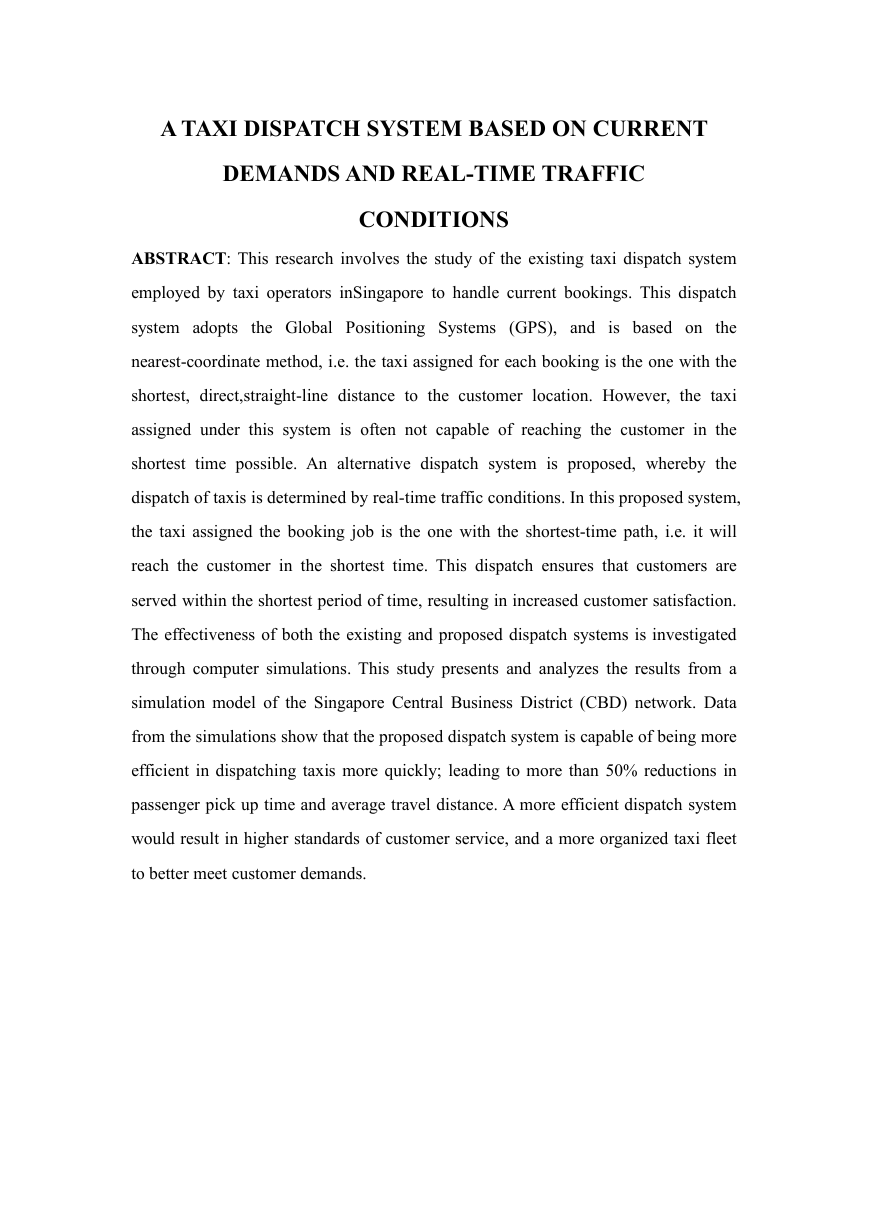
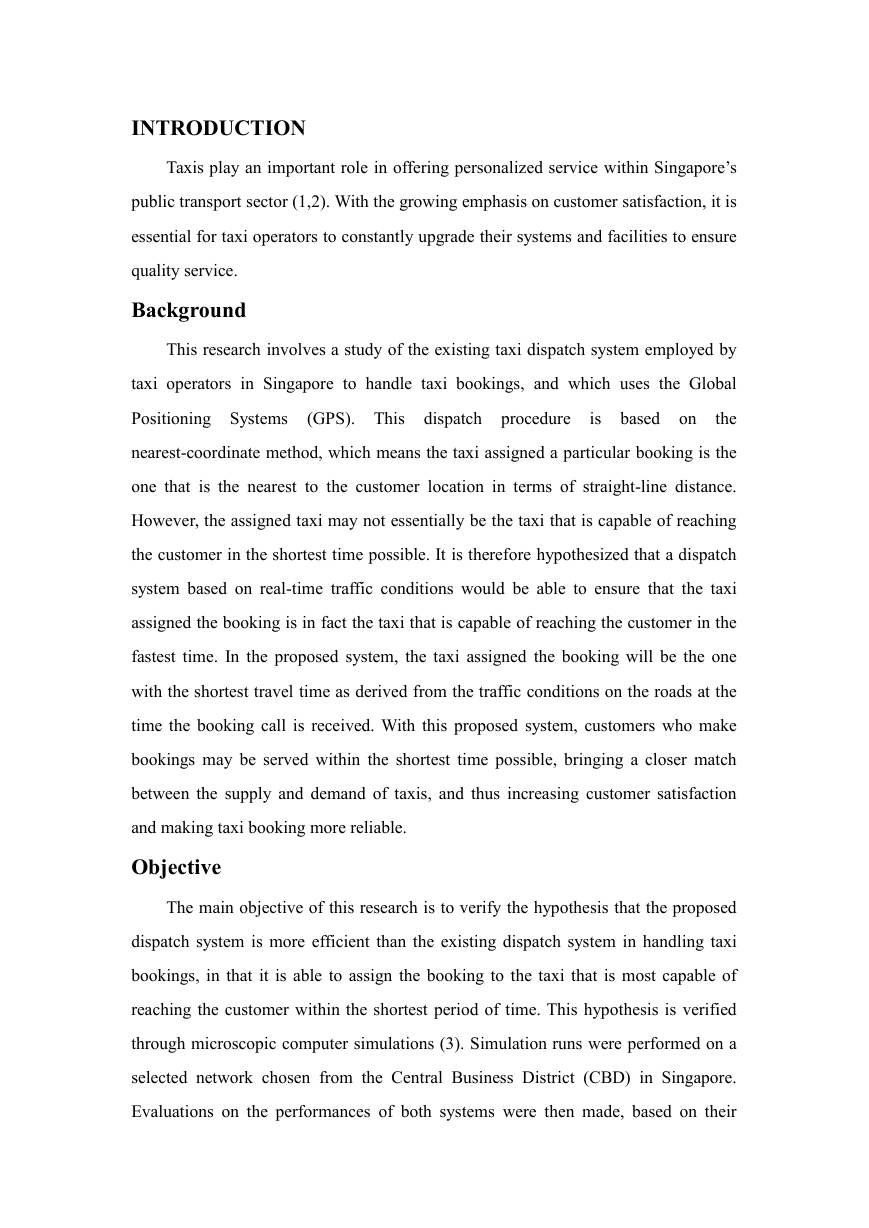

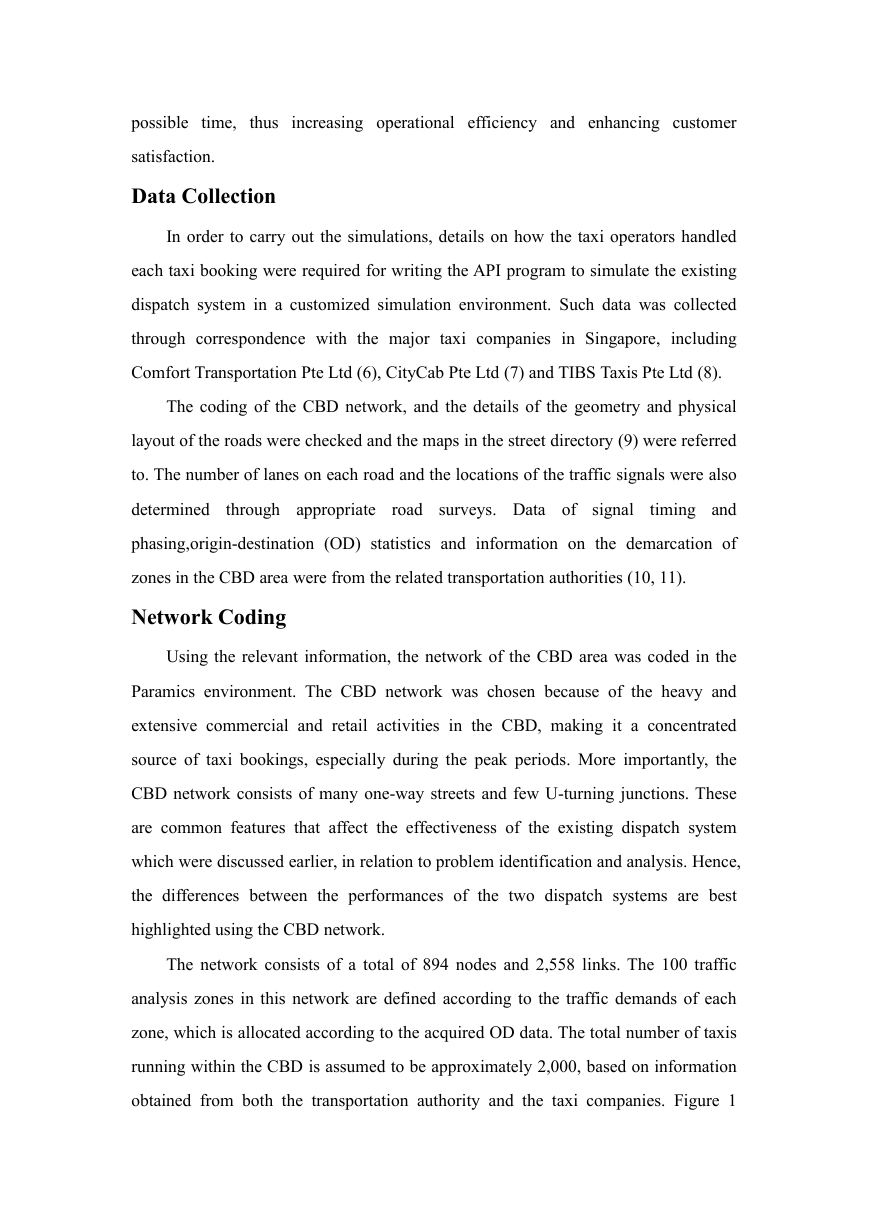
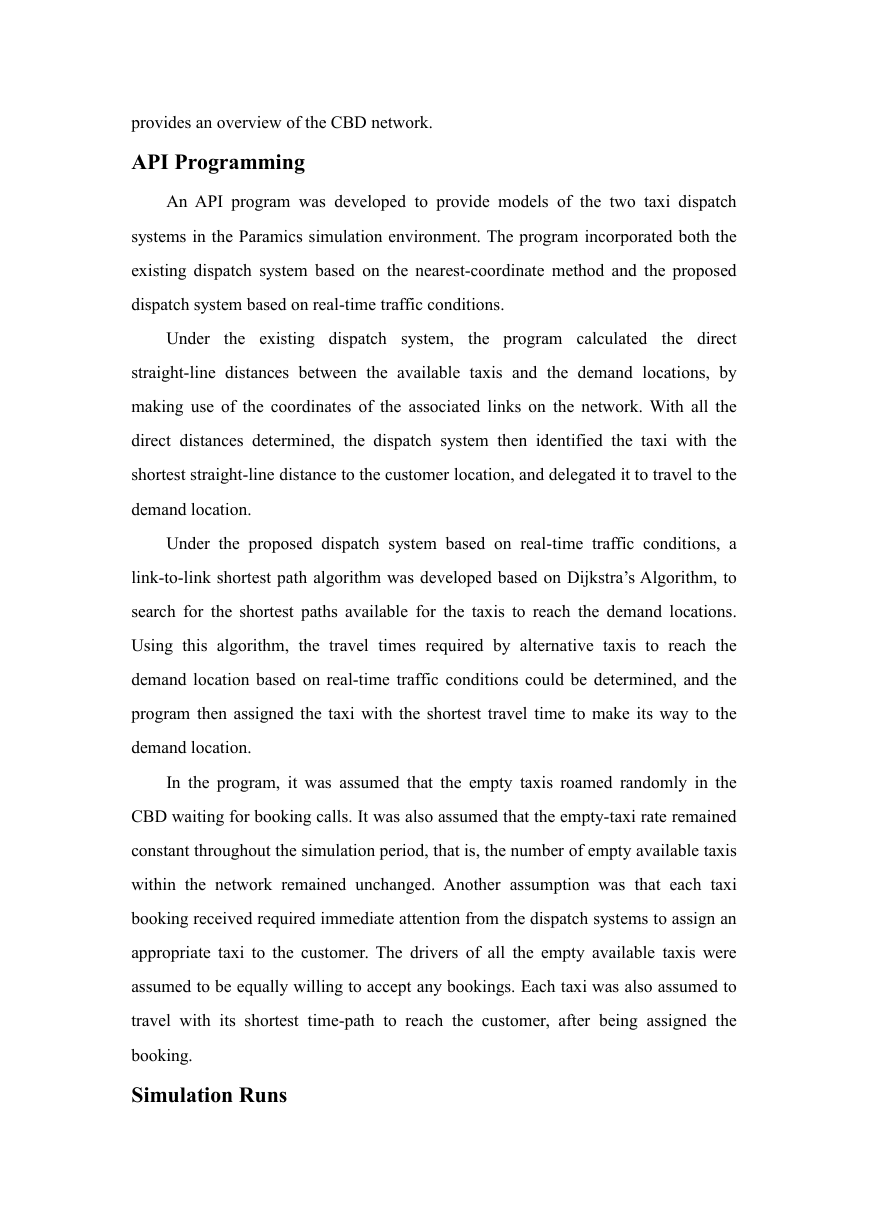
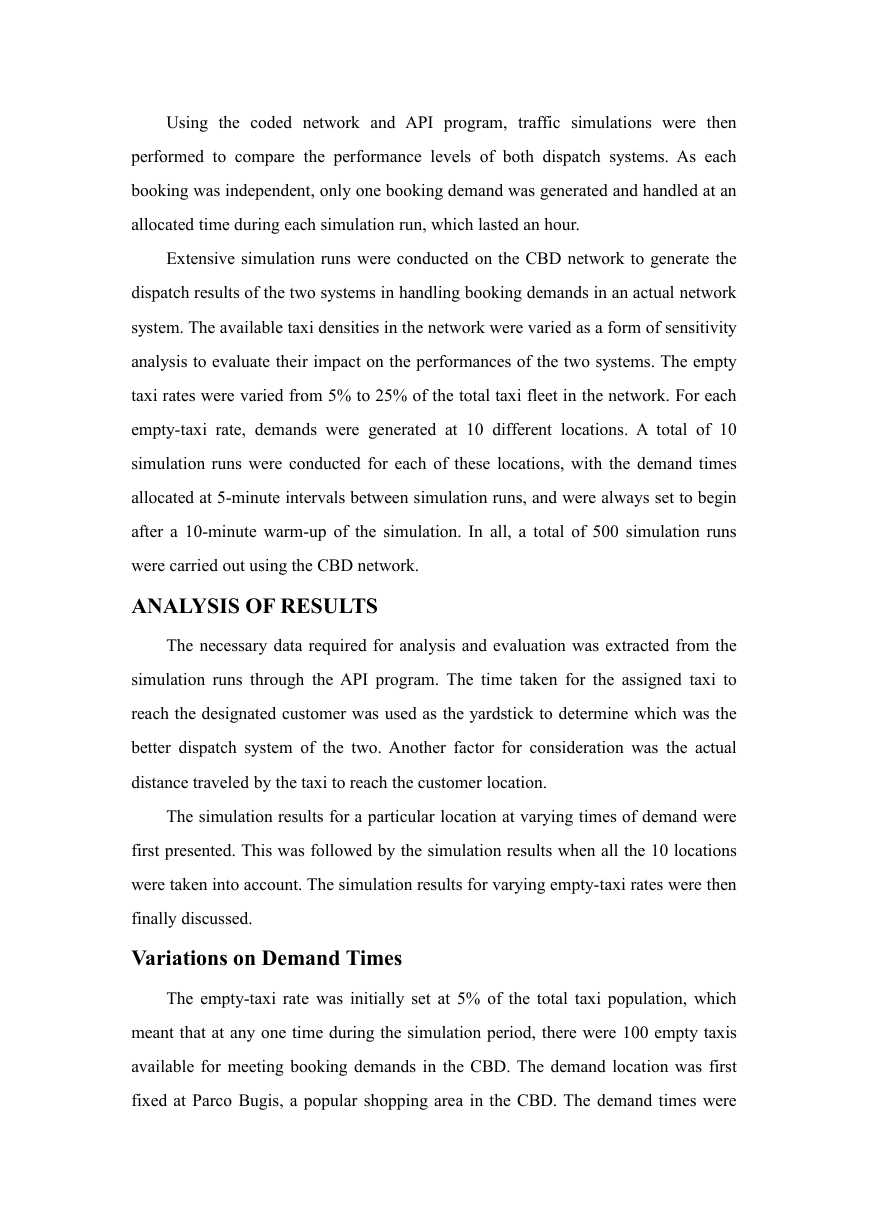
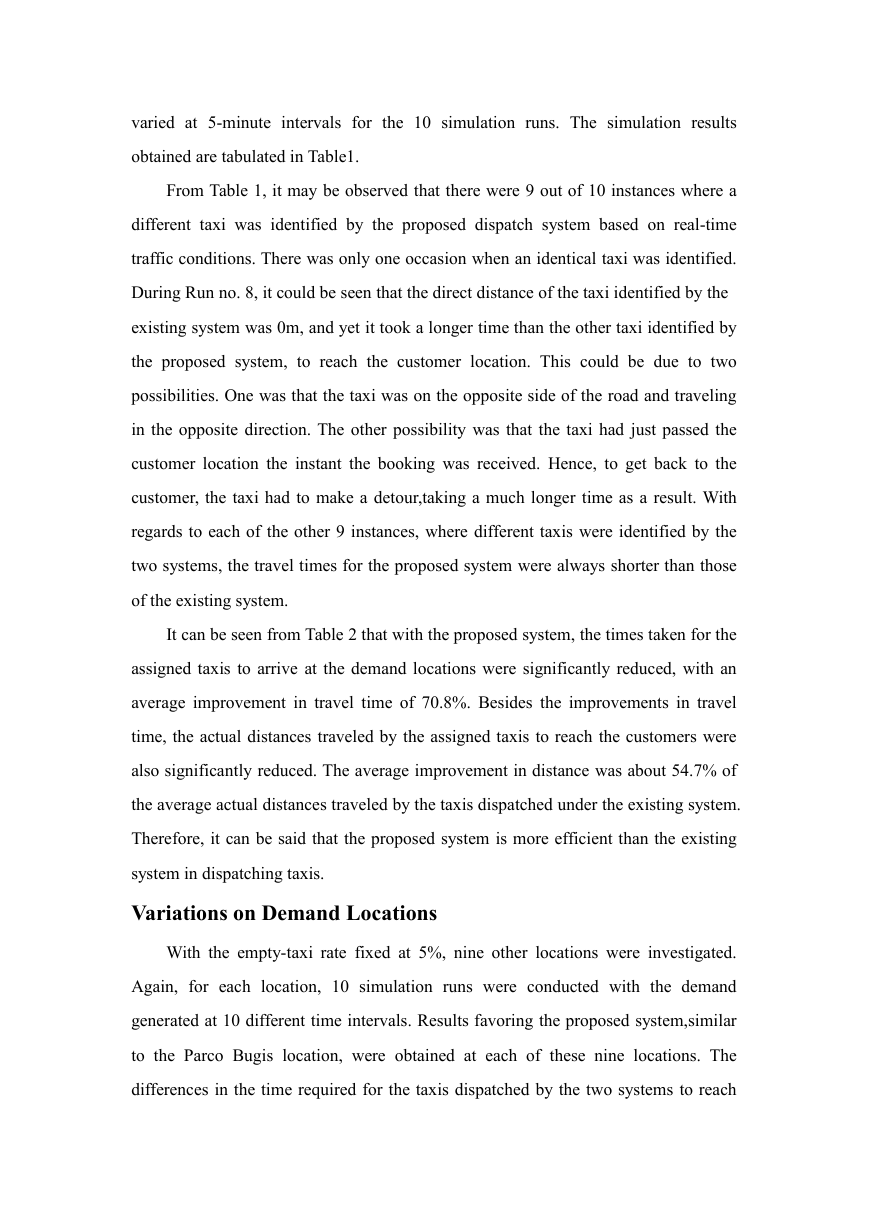
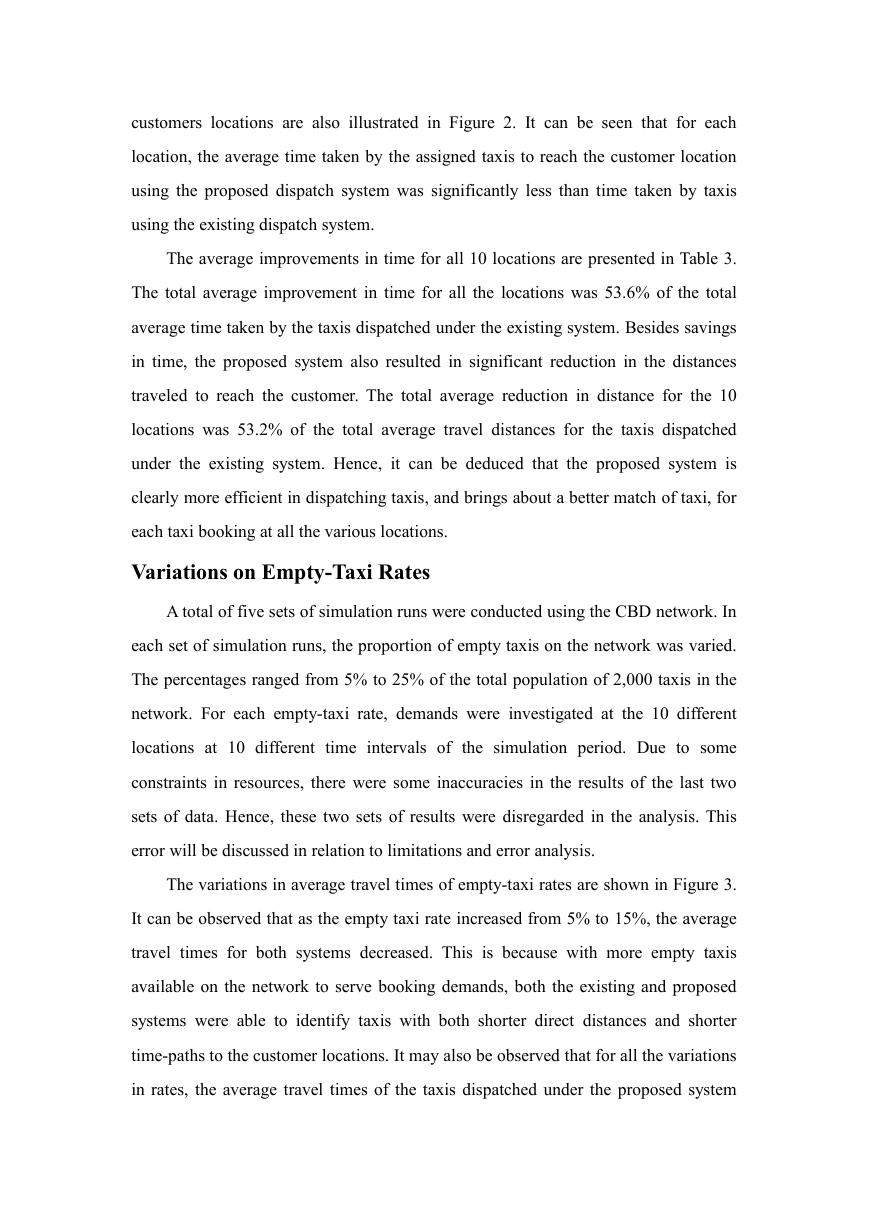








 2023年江西萍乡中考道德与法治真题及答案.doc
2023年江西萍乡中考道德与法治真题及答案.doc 2012年重庆南川中考生物真题及答案.doc
2012年重庆南川中考生物真题及答案.doc 2013年江西师范大学地理学综合及文艺理论基础考研真题.doc
2013年江西师范大学地理学综合及文艺理论基础考研真题.doc 2020年四川甘孜小升初语文真题及答案I卷.doc
2020年四川甘孜小升初语文真题及答案I卷.doc 2020年注册岩土工程师专业基础考试真题及答案.doc
2020年注册岩土工程师专业基础考试真题及答案.doc 2023-2024学年福建省厦门市九年级上学期数学月考试题及答案.doc
2023-2024学年福建省厦门市九年级上学期数学月考试题及答案.doc 2021-2022学年辽宁省沈阳市大东区九年级上学期语文期末试题及答案.doc
2021-2022学年辽宁省沈阳市大东区九年级上学期语文期末试题及答案.doc 2022-2023学年北京东城区初三第一学期物理期末试卷及答案.doc
2022-2023学年北京东城区初三第一学期物理期末试卷及答案.doc 2018上半年江西教师资格初中地理学科知识与教学能力真题及答案.doc
2018上半年江西教师资格初中地理学科知识与教学能力真题及答案.doc 2012年河北国家公务员申论考试真题及答案-省级.doc
2012年河北国家公务员申论考试真题及答案-省级.doc 2020-2021学年江苏省扬州市江都区邵樊片九年级上学期数学第一次质量检测试题及答案.doc
2020-2021学年江苏省扬州市江都区邵樊片九年级上学期数学第一次质量检测试题及答案.doc 2022下半年黑龙江教师资格证中学综合素质真题及答案.doc
2022下半年黑龙江教师资格证中学综合素质真题及答案.doc